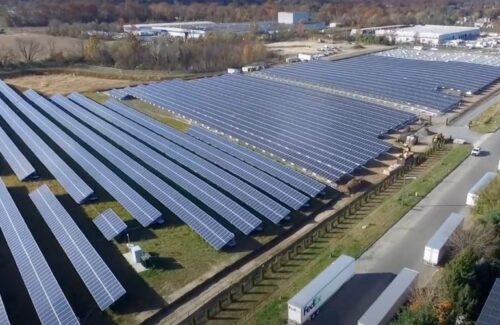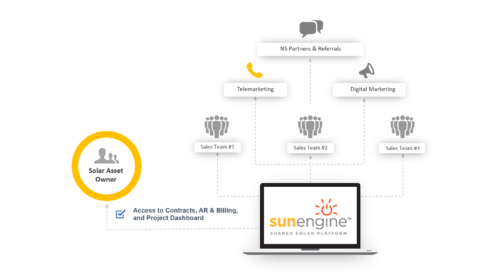
The Tri County solar array in Delanco, New Jersey was developed by Soltage and uses Neighborhood Sun’s SunEngine community solar software platform.
By Armando Gaetaniello, VP of business development, Neighborhood Sun
Community solar has been growing throughout the U.S., with over 3.6 GW of projects operating in late 2021 and deployments expected to increase by 4.5 GW of capacity in the next five years. The U.S. DOE has set a goal for the equivalent of 5 million American homes to be powered by community solar systems by 2025.
But managing the projects can be unnecessarily complex, which can hamper their deployment. To accelerate community solar growth and achieve the DOE’s goal, we must eliminate as many complexities as possible.
A good community solar software platform goes a long way toward simplifying projects — helping to attract and retain customers, save time and increase revenues for developers and asset owners.
Given these benefits, what should developers and asset owners look for in a community solar billing platform?
1. Flexibility and customization
Anyone who works in community solar knows that it’s a complex market segment. Community solar business models and regulations vary widely across the U.S. and regulations constantly change in this fast-moving market. Even within the same state, multiple business models may be available. And every developer has unique challenges, with different needs for different customer types.
That’s why flexibility and customization — to accommodate the needs of subscribers and those of developers and asset owners — are essential for a community solar billing platform. But such platforms have often been too rigid to account for varying structures, changing regulations and diverse customer types.
To provide flexibility and customization, a community solar billing platform should:
- Allow you to manage a combination of multi-state or multi-utility projects and portfolios across different teams.
- Allow tailoring for different needs of outreach and marketing:
- For example, signup pages might use different messages for different audiences, such as an environmental group or a community group like a congregation.
- Different sales teams selling the same community solar project in the same utility may want to each have their own signup page that uses their language and brand. This can be applied to your own internal or an external sales team.
- All of these efforts need to be tracked in detail to assess performance and effectiveness of the outreach strategy.
- Incorporate the regulations and structures for each state and update them regularly to keep up with changing policy landscapes; this includes adding new markets as they open up.
2. White-labeling or software-as-a-service
Many community solar billing platforms don’t include true white labeling, but developers and asset owners shouldn’t overlook this feature. Whether you’re new to the community solar market or a veteran, a true white labeling implementation allows you to build a strong brand presence and maintain and strengthen relationships with your subscribers. True white labeling also allows you the flexibility of partnering with other solar companies while fully subscribing your own projects. Some platforms offer what they call a “white label,” but it’s just throwing your branding on an existing structure that is used by many other companies.
Perhaps the most significant advantage of a true white label function is that it allows each developer or asset owner to use a separate database, which provides an essential layer of privacy and security. This is key for any organization that has its own billing and customer service department and that interfaces directly with a utility to manage subscribers. Each organization, although utilizing the same SaaS platform, should also be able to configure certain aspects in its own customized way.
3. Ease of signup and use for subscribers

Neighborhood Sun’s SunEngine community solar software platform.
Despite its current growth, community solar is still a new concept to most individuals and businesses — so it can be confusing for subscribers. That can create churn for both subscribers and community solar companies.
It’s crucial for a community solar software platform to make it easy for subscribers to sign up. To provide customers with the information they need and ensure that they don’t waste time going through unnecessary steps, enrollment should be customized to suit state and utility program requirements.
Once a customer is subscribed, they should be able to easily access their information in one place; this includes seeing their invoices and tracking their savings, adjusting their account details and monitoring their impact. A smooth user experience means you’ll spend less time on the phone answering customers’ questions — which will save you money and increase customer retention.
4. One-stop shop for asset owners and developers
A good community solar software platform should provide a turnkey one-stop shop for asset owners and developers.
It should include tools like a management dashboard, referral codes and promotional codes to empower your sales teams as they engage with and market to their clients. It should allow tracking of all marketing and sales efforts.
Software integration is a critical component of an effective one-stop shop. You shouldn’t have to worry about your billing and reporting packages not working well together. It’s easy to see how a billing platform that integrates with your CRM can make your life much easier, providing easy access to the data you need about your customers. Effective and efficient platforms should also integrate with payment processors, e-signing software, utilities and credit agencies.
Seamless integration with all relevant software platforms eliminates the need to create workarounds and gives you easy access to the data you need, ensuring accuracy and saving you time and money. An organization with dozens of community solar assets should have one central place to add, edit, replace and switch customers without having to update those records multiple times because the different softwares don’t talk to each other.
5. Data and reporting
 Speaking of easily accessible data, your community solar software platform should make it easy to track data, such as how many subscribers you have, how much room is left in a solar project and billing cycles. The platform should also automate accounting and reporting processes that might otherwise have to be done manually. This can include mapping utility data, generating invoices and tracking projects.
Speaking of easily accessible data, your community solar software platform should make it easy to track data, such as how many subscribers you have, how much room is left in a solar project and billing cycles. The platform should also automate accounting and reporting processes that might otherwise have to be done manually. This can include mapping utility data, generating invoices and tracking projects.
Reports should be customizable and include a process for reconciling data from customers, asset owners and utilities. Spotting a discrepancy in the reported power generation data between the utility and the community solar company can help lead to a quick resolution.
Community solar projects involve numerous stakeholders, such as community solar providers, developers, asset owners, financiers and utilities. The ability to easily gather data about a project and share it among these various channels can help strengthen relationships with all of these parties.
Pulling it all together
In today’s market, there’s no need to settle for a community solar software platform that does not include all the features detailed here. Beyond these elements, it’s a good idea to consider who has built the platform. What is the team that stands behind the platform? Who will you reach when you call about issues — a senior person or a junior staffer?
A deep understanding of the complex community solar market, based on extensive experience with both the financial considerations and the energy industry, will ensure that the platform suits your needs. While many software developers could build a complex platform, developers and asset owners should engage a team that understands the industry and offers a platform that will deliver the best results.
Neighborhood Sun is a Certified B-Corporation, meeting the highest environmental, community, governance and employee standards in the business and was recently awarded a prestigious “Best for the World – Environment” award.





Given that the “carbon crisis” was created by a stupendous increase in energy dependent people using autos, clothes dryers, electric ovens and air conditioners and battery everything of course the world’s population craves energy. Very, very different from 100 years ago when folks generally lived in towns as the “burbs” were just starting to grow. with the burbs came more need of those nifty automobiles and heat sucking roads and roofs. Not to mention the 100 or so thousand square miles of woods that got annihilated for houses and roads.
Too attack the atmospheric problem at the root (if indeed it is a problem we can affect) we should be getting solar on every roof to lessen our need for electricity generation at the cost of 1-$2 of coal per KWH. Start with the less affluent housing with an 1800 kw per house installation PAID for by we the people.
This does two things 1. we the people feel good because we helped others lower their juice costs and #2 society is helped by a little less dependence on the enslaving grids.
And further, the city fathers need to band together to change the minimum insulation requirements on all structures. In the USA we bleed our structure’s heat into the atmosphere in both winter and summer. (My house here in SC was built in 2005 and has exactly the same wall insulation as the houses I was building (was just a teen) in the late 1950’s. That is absolutely stupid given present knowledge. We could even use closed cell foam to capture carbon and cut heat loss (or gain) by 50% or better. Ditto insulating the underside of roofs rather than just blowing it into the attic.